Full Description
John Anderson and Colin Ewen, two of the most notable exponents of 'dependency phonology', present in this book a detailed account of this integrated model for the representational of segmental and suprasegmental structure in phonology. Dependency phonology departs from traditional 'linear' models of phonology, and the more recent non-linear models of autosegmental and metrical phonology, in several respects. Unlike in these models, suprasegmental structure is derived directly from the segmental representations, and these representations are based on single-valued features, or components (rather than Chomsky and Halle-type binary features), linked by the dependency relation to form suprasegmental structures, with the exact nature of the dependency relations being directly determined by the properties of the segmental structure. Phonology is currently noteworthy for the diversity of views within the discipline, but no linguist or phonetician with a serious interest in phonology can afford to ignore this book or fail to be interested by it.
Contents
Part I. Phonological Structure: 1. The structure of phonological segments; 2. The structure of phonological sequences; 3. Dependency structures in phonology; Part II. Phonological Gestures and their Structure: 4. The categorical gesture: phonation; 5. The categorical gesture: initiation; 6. The articulatory gesture; Part III. Overview: 7. Conclusions and consequences.
-

- 電子書籍
- 栃木 しあわせのランチ こだわりの味と…
-

- 電子書籍
- 別冊文藝春秋 電子版52号 (2023…
-

- 電子書籍
- noicomi書けないこととか、いけな…
-

- 電子書籍
- 霊能占星師・天野みき鑑定ファイル(分冊…
-

- 電子書籍
- PROJECTORS Vol.35



